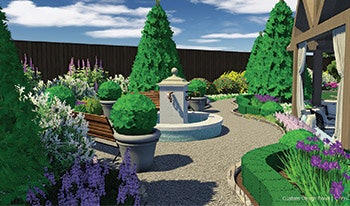For the past several years, we've often heard that there are great potential rewards waiting for pool designers and builders who work beyond the water's edge. It's become almost a cliché call to arms for builders looking expand their horizons.
Some builders have embraced that concept while others have stayed with their water-only focus. Some see it as a way to elevate their bottom lines and reputations, while others believe it's better to spend their time doing what they already know best.
Certainly you can find success either way, but as one might guess from our company's name, Custom Design Pools & Landscaping (Houston, Texas), we've moved in the direction of comprehensive exterior designer, and we do so having recognized not only the benefits of completely integrated design from a creative standpoint, but also in terms of how it expands our business and ultimately profit margins.
But it wasn't always that way.
POOL ROOTS
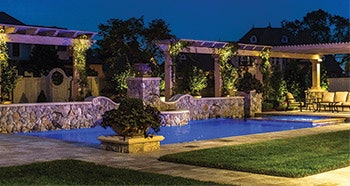
I was basically raised in the pool business. My dad, Bob Anderson, started working for pool builders back in 1980, the year I was born, and eventually founded our company in 1994. Most of the projects he did were for middle class and upper-middle class clients, building pools averaging about $70,000.
RELATED: Like Father, Like Son
My dad never really pushed design other than as a way to close sales, which was standard practice for the industry and still is for many companies. But his pools were always extremely well built and were, for the most part, perfect for his clientele. He's one of those guys you could count to do a quality job and provide solid value for the money spent.
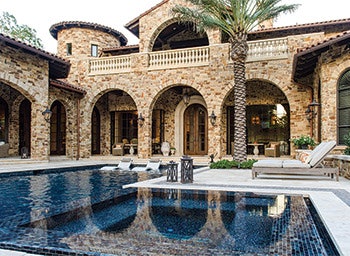 By expanding our work beyond the water's edge, we're able to increase profits and provide greater overall value to the homeowner.
By expanding our work beyond the water's edge, we're able to increase profits and provide greater overall value to the homeowner.
I joined the company in 2007 and very quickly started seeing things with fresh eyes from a business perspective. My dad spent most of his days running projects and only had time in the evening to reflect on the business. Like many, the momentum of running a successful company kept him in the same business mode.
When I came on the scene, I had the advantage of spending all my working hours looking at how the company could become more profitable and perform greater service to our customers. I made contacts outside the industry in landscape and patio furniture, and connected with all types of material suppliers. Then I started exploring all the different types of areas that could enhance the core of the business, which was — and remains — designing and building pools.
Of course, shortly after I joined the company the economy tanked, but by then we had already decided to push our work in a much broader (and as it turned out, far more profitable) direction — a path that has led us into the exterior-design genre.
PROFIT PLANTS
While that type of evolution encompasses much more than simply adding landscaping to the menu, embracing landscape design (meaning hardscape and softscape) is a logical step. What many builders are afraid of, however, is that if they start trying to sell all this other stuff, homeowners will have less money for the pool. So what's the point?
Using landscape as a specific example, we've found the opposite to be true. We were outsourcing landscaping for a long time, but then I looked at the profit we were making, how long it was taking to earn those margins and how much we could make if we brought it in-house.
Let's say your make 15-percent profit on a $100,000 pool that takes three months to install. You're making $5,000 a month. Now let's say you install a $60,000 landscape that takes you three weeks to install at 30-percent profit. Now you're making $18,000 profit in three weeks, on top of the proceeds from the pool.
RELATED: How to Break Into Outdoor Living
We've found landscape work takes much less time to install, and when you bring it in-house you can command higher margins. The same thing applies to outdoor kitchens, lighting systems, fire elements, outdoor courts, play structures, putting greens or even treehouses — all of which we offer our clients.
Now, here's an even more dramatic example of how builders can use the same kind of calculation to their advantage. We sell patio furniture as part of our projects. It's not unusual for us to put together a $6,000 package for a client and make $1,500 profit. But all we have to do is make the selections, place the order and be there the day the furniture shows up.
If we have our act together, we can present furniture options in the same way we present tile or coping or any other menu option. We don't sell all of these ancillary items on every project, and it's always a different combination of things, but when you consider the potential for increased profit with less time spent, doesn't it make sense to make those options available to your clients?
CONSUMER BENEFITS
To be perfectly clear, as important as the increased margins may be, looking at the dollars is only one part of the picture. In my mind, the benefits both to your business and the consumer are even greater than the dollars and cents.
Again, looking at the landscape and patio furniture, shouldn't we be the ones making those decisions since we're also the same people designing the deck? When one company builds the pool, another designs and installs the landscape and the consumer goes out after the fact and buys their own furniture, it becomes impossible to control the ultimate impression, the emotional reaction, that the exterior environments generate in the hearts and minds of homeowners.
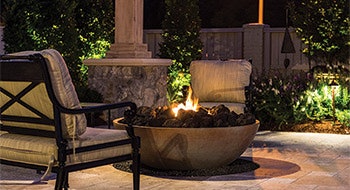 Amenities such as fire features and outdoor furnishings afford opportunities to create harmonious designs.
Amenities such as fire features and outdoor furnishings afford opportunities to create harmonious designs.
I think of it this way: If you look at the most beautiful pool that has no landscaping around it, or a deck that is void of furniture, it doesn't matter how well the work is done — the space looks unfinished and uninviting. When filling in those critical elements is left to others, the process becomes hit and miss. Yet it's that overall finished impression that ultimately drives referral business. When we don't step into that void and make the appropriate design decisions, the odds are something isn't going to harmonize visually or functionally.
It's those small things that make the biggest difference in many situations. If, for example, the furniture package includes red fabrics, I'm going to be certain that the color scheme works with the deck material and I'm also going to select red flowering plants. Those kinds of small harmonics might not jump out at the client, but in their absence, there will be an uneasy feeling that something's not right, or not as beautiful as it could be.

In the end, by bringing all those decisions under your purview, you are better serving the homeowner. For the exact same dollars, you're able to give them far better value. After all, we're the ones who should know the different material options and the best vendors. For as informed and opinionated as many homeowners are these days, we serve them well by working with the entire outdoor environment.
It's very similar to how an interior designer works. They don't choose the paint color, flooring and furnishings but leave the kitchen cabinets to another company. That doesn't happen in that profession because it's been long established that you hire an interior designer precisely because they know how to make all the pieces work together. Shouldn't our industry work the same way for the same exact reasons?
WHAT ARE WE?
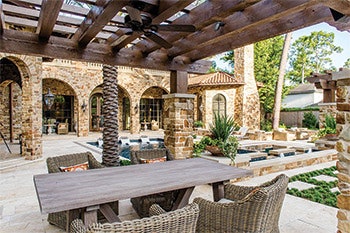 From creative hardscape treatments to outdoor rooms and dining areas, our work encompasses a wide range of menu items.
From creative hardscape treatments to outdoor rooms and dining areas, our work encompasses a wide range of menu items.
Ultimately, because we've broadened our approach from strictly pool builders to "exterior designers," the homeowner gets a more integrated, harmonious and interconnected design. Doubling back to the concern of taking money from the pool to pay for other design elements, when you present projects in totality, clients see for themselves the increased value, and more often than not, they find the money for those features that they believe will make them happy and even improve their lives.
It's amazing the shift in perspective that happens when you offer comprehensive projects. Homeowners will very quickly start to view you as a collaborator, someone who is bringing their dreams to fruition, and not as someone who's simply trying to sell a project. It's a completely different, and better, type of discussion than an obvious sales pitch.
I've found time and time again that homeowners have absolutely no problem with the idea of us making good money on the work, so long as they believe our priority is giving them exactly what they want and need. By contrast, when they see you as a contractor earning profit on the pipes and concrete, that's when they start to question every nickel and dime.
RELATED: The Secret Behind Emotionally Compelling Landscape Design
It's interesting, and almost counterintuitive, how by charging for design, precisely because we're offering more options in a more sophisticated way, clients value our work on an entirely different level. Sure, being compensated for the design process enables us to comfortably spend all the time needed to get it right, but more importantly, it tells the homeowner that we bring something to the process they can't find on their own or with a company that uses design primarily as a selling tool.
Yes, we are still "pool builders" in the sense that we do design and build swimming pools on all our projects. And I salute my dad for his decades of working hard to make a living in the traditional builder mode. (It also bears mentioning that many homeowners' first call when they're developing a landscape is to call the pool company.)
But we've learned over and over again that by looking beyond the water's edge, we're able to make far more profit on much larger projects, and most important, we're better to provide our clients with end results that consistently exceed their expectations.
The Power of Presentation
As our company has moved farther and farther into the world of integrated exterior design, the importance of detailed and inspiring presentations has become more and more important. In our work, we've long embraced Pool Studio from Structure Studios. Our clients respond to the 3-D perspective presentations that enable them to visually and even mentally travel through their environment. The program has become progressively more detailed with all sorts of standardized and custom elements — fire features, landscaping, patio furniture and finish materials etc. — already pre-loaded in the program. Certainly there are many computer-aided-design programs available and we all need to choose the software that best suits our needs and design skill level. Whichever you choose, the bottom line is that if you're going to work as true designers, and not as someone simply using design to close a sale, you're going to need to elevate your game on this front, because customers these days expect to impressed by visual presentations. In the same respect, I've come to believe that video, as opposed to still photography, is where project portfolios and galleries are going. Landscapes, especially those that contain pools and other aquatic elements, are by their nature interactive. Static images fall short, I believe, in capturing the experiential nature and potential of well-designed exterior spaces. |
Lounging on the LedgeMost anyone working pool design and construction knows that over the past 10 to 20 years, the tanning ledge, a.k.a. Baja shelf, has become an increasingly popular feature. Homeowners like the idea of relaxing in shallow water. Back in 2010 it dawned on me that with that development, there have been a couple of big disconnects. For one, when we put metal furniture in water, shouldn't those objects be electrically bonded the same way handrails or light rings are? And as an extension, why isn't there furniture designed specifically for that purpose? As I mentioned in the adjoining discussion, we've moved into patio furniture in a big way as part of our movement into overall exterior design. All of that is why we took the unusual step of designing and manufacturing our own line of furniture for use in shallow water. To make a long story short, we developed a set of loungers and associated items we call the Ledge Lounger. It's all made of a resin that was formulated to withstand the rigors of water treatment with forms and colors that accommodate the aesthetics of the pool setting. As we've worked with clients and offered the Ledge Lounger as an option, an interesting thing started to happen. Many homeowners now want to make their tanning shelves larger to accommodate not only the furniture they know will occupy that space but also the social interaction and luxury they visualize taking place there. The other big disconnect with patio furniture in general is that most builders don't realize that they're the perfect people to offer quality furnishings. As I also mentioned, we have the ability to integrate those pieces into the overall design, but there's also a timing issue. Typically when a project's finished, that's when homeowners suddenly realize they need furnishings and being modern consumers they want what they want immediately, which leads the to the limited world of off-the-shelf products. Because we're on site for several weeks building the project, we have the luxury of being able to accommodate the lead time needed for custom furnishings because we ordered it early on in the process. By the time the project is finished, the furniture has arrived and we're able to hand over a completed environment. I believe the entire pool building industry would do well to think differently about these types of products that, when all is said and done, will have as much to do with customer satisfaction as the pool finish or decking material. |
Comments or thoughts on this article? Please e-mail [email protected].
















